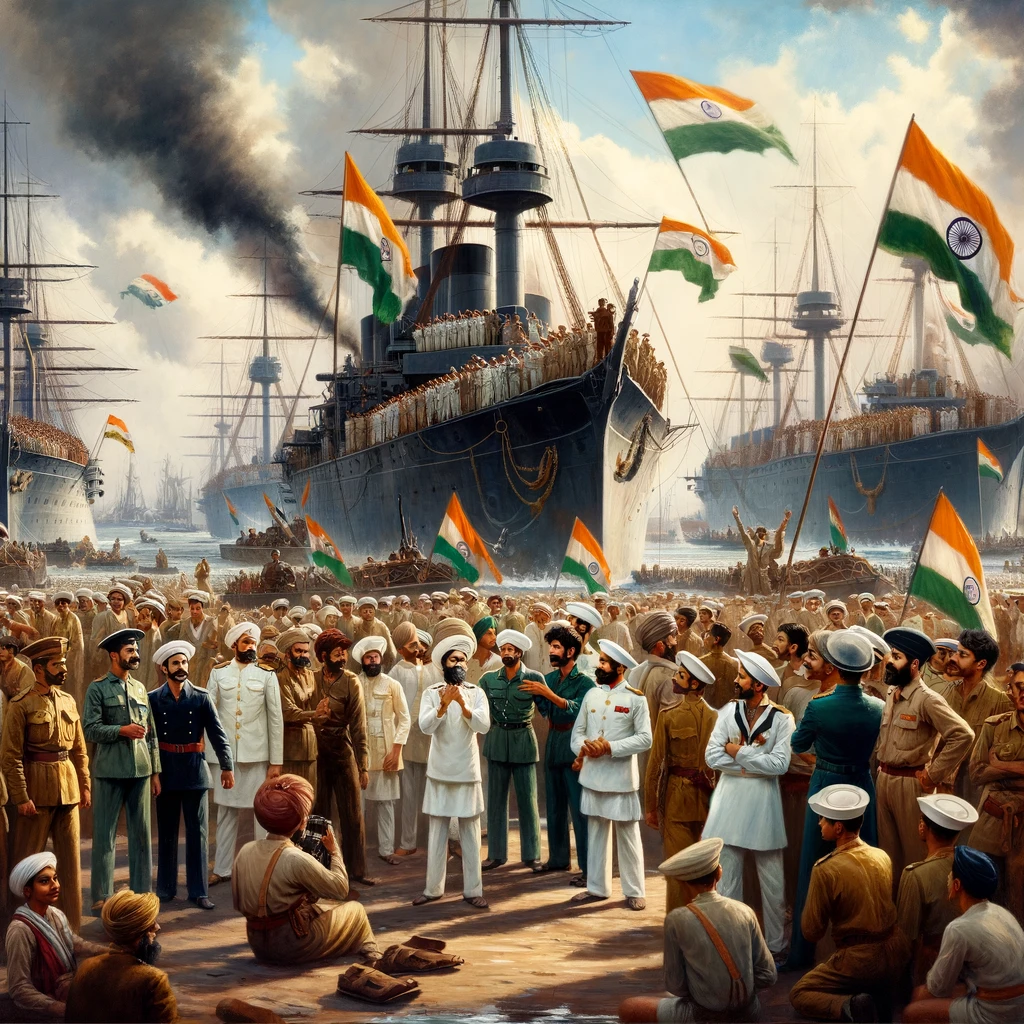Freedom Struggle: Defining Moments of February 21
February 21st has witnessed pivotal events that have significantly shaped the course of India’s struggle for independence. Among these, the Royal Indian Navy Mutiny of 1946 stands out as a key moment of defiance against colonial rule.
Table of Contents
ToggleRoyal Indian Navy Mutiny, 1946
The Royal Indian Navy (RIN) mutiny of 1946 began on February 18th, with significant developments unfolding on February 21st. This widespread rebellion against British authority involved over 20,000 naval ratings and affected around 80 ships and 20 shore establishments across India. The mutineers hoisted the flags of the Congress, the Muslim League, and the Communist Party, symbolizing unity against the British colonial rule.
Key Events on February 21
On this day, the situation escalated notably in Karachi with the HMIS Hindustan resisting British forces. This resistance was marked by intense confrontations, with sympathies from the Gurkha and Baluch regiments who refused to fire at the mutineers.
Sacrifices on February 21
The sacrifices made on February 21st are a testament to the indomitable spirit of those who fought for India’s freedom and justice. This date is particularly marked by the tragic events of the Akali Movement and the Nankana Massacre in 1921.
Akali Movement and Nankana Massacre, 1921
Bagh Singh and Comrades
Bagh Singh, Banta Singh (from Thihara), another Banta Singh (from Bihala), and Bara Singh were involved in the Akali movement against malpractices in Punjab. They were part of a Sikh Jatha to Nankana Sahib when attacked by the Mahant’s men on February 21, 1921, leading to their martyrdom.
Jaito Morcha, February 21 1924
Kapur Singh and Allies
Kapur Singh, Ram Singh, Sunder Singh, and Dewan Singh were part of the non-violent Shahidi Jatha to Jaito Gurdwara Gangsar, Nabha. On February 21, 1924, as they approached the Gurdwara, British-led troops opened fire, resulting in their tragic deaths.
Uprising of 1857 and Aftermath
Sooplull Dubey
Sooplull Dubey, who left the English East India Company army during the Uprising of 1857 and fought against the Company armies, was captured and died in detention on February 21, 1859.
Tebhaga Movement, February 21 1947
Chand Sukur and the Movement
During the Tebhaga movement in Dinajpur, on February 21, 1947, police fired on peasants gathered to prevent the arrest of a leader, resulting in the deaths of Chand Sukur, his wife, Muktu Singh, and Nendeli Singh.
Civil Disobedience Movement, 1930s
Asarfi Mandal and Mahipal Singh
Participants in the Civil Disobedience movement of 1930, Asarfi Mandal and Mahipal Singh were involved in a confrontation on February 15, 1932, and succumbed to their injuries on February 21, 1932.
Anushilan Samiti and Freedom Fighters
Birendranath Datta Gupta
A member of the Anushilan Samiti, Birendranath Datta Gupta assassinated DSP Khan Bahadur Shamsul Alam in 1910 and was executed on February 21, 1910.
These events and sacrifices highlight the multifaceted struggle for Indian independence, showcasing the breadth of resistance against colonial and oppressive forces across different regions and times.
Feature Image: Click here to view the image.
SOURCES:
- Volume -1 Part -I [Delhi, Haryana, Punjab and Himachal Pradesh 1857-1919]
- Volume -1 Part – II [Delhi, Haryana, Punjab and Himachal Pradesh 1920-1947]
- Volume -2 Part – I [UP, Uttarakhand, MP, Chhattisgarh, Rajasthan and J&K 1857-1947]
- Volume -2 Part – II [UP, Uttarakhand, MP, Chhattisgarh, Rajasthan and J&K 1857-1947]
- Volume -3 [Maharashtra, Gujarat and Sind 1857-1947]
- Volume – 4 [Bengal, Bihar, Jharkhand, Odisha, Assam, Arunachal Pradesh, Manipur, Meghalaya, Mizoram, Nagaland and Tripura 1857-1947]
- Freedom on the Waves: The Story of the 1946 Indian Naval Mutiny (thewire.in)

I¦ve recently started a website, the information you offer on this web site has helped me greatly. Thanks for all of your time & work.
I envy your work, thankyou for all the interesting content.